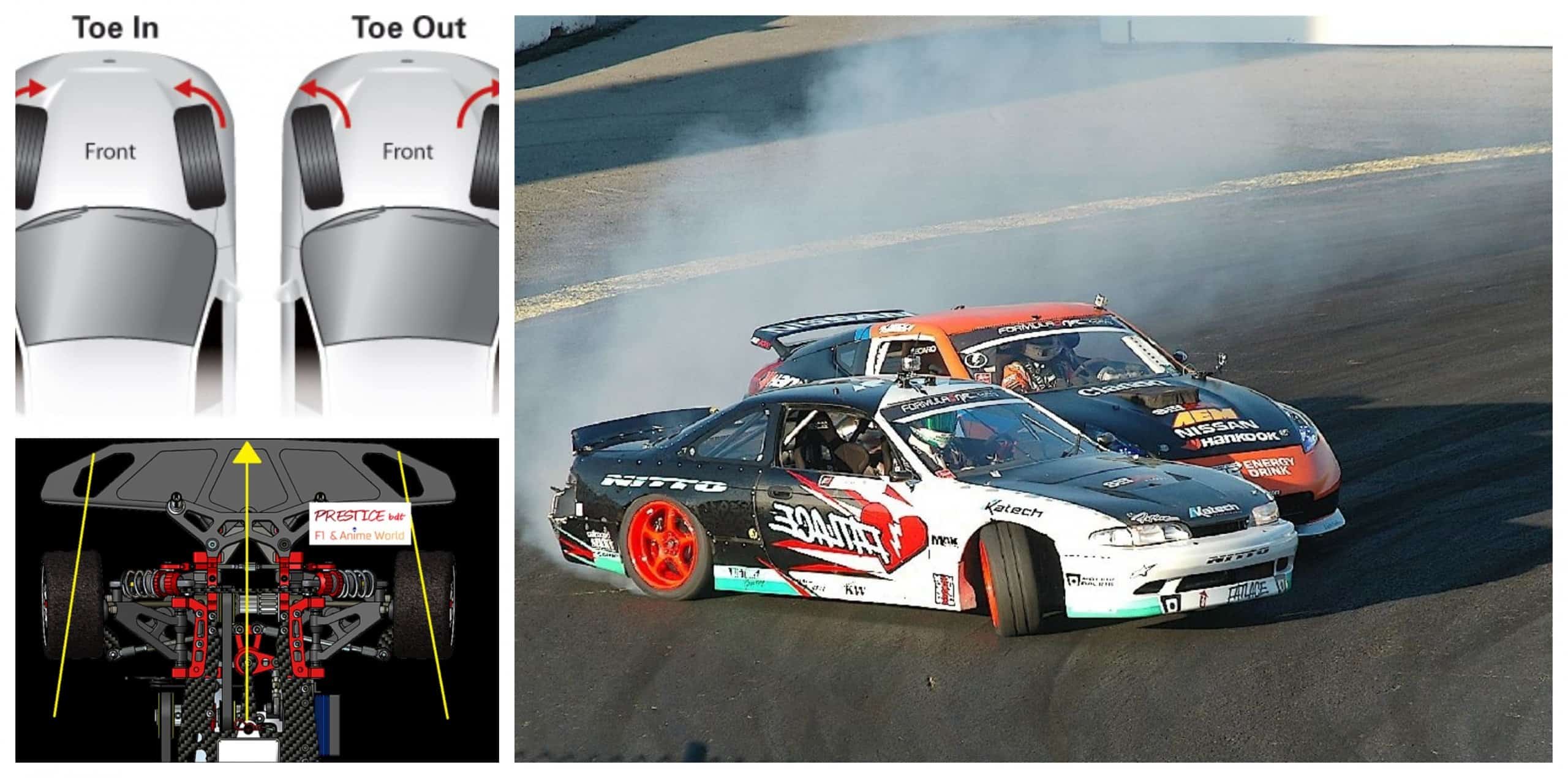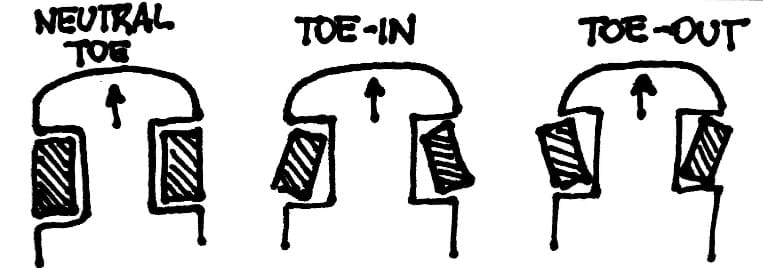TIRE TOE ANGLE ADJUSTMENT EXPLAINED
Car stability and reactivity are affected by the toe angle alignment
Toe angle adjustment in the automotive sector.
What is toe angle in a car?
Toe is the side-to-side difference in distance between the front and rear of the front tires. If the distance is closer at the front, it’s called toe-in (leading edges are pointed slightly towards each other). If the difference is closer at the rear, it’s called toe-out (he leading edges point away from each other). The toe angle, together with camber and caster angle is one fundamental parameter for suspension setup.
The amount of toe can be expressed in degrees as the angle to which the wheels are out of parallel, or more commonly, as the difference between the track widths as measured at the leading and trailing edges of the tires or wheels. Toe settings affect three major areas of performance: tire wear, straight-line stability and corner entry handling characteristics.
Toe angle definition: toe in and toe out.
Toe is the symmetric angle that each wheel makes with the longitudinal axis of the vehicle, as a function of static geometry, and kinematic and compliant effects. This can be contrasted with steer, which is the antisymmetric angle, i.e. both wheels point to the left or right, in parallel (roughly). Negative toe, or toe out, is the front of the wheel pointing away from the centerline of the vehicle. Positive toe, or toe in, is the front of the wheel pointing towards the centerline of the vehicle. Toe can be measured in linear units, at the front or rear of the tire, or as an angular deflection.
In a rear wheel drive vehicle, increased front toe in provides greater straight-line stability at the cost of some sluggishness of turning response. Performance vehicles may run zero front toe or even some toe out for a better response to steering inputs. The wear on the tires is marginally increased as the tires are under slight side slip conditions when the steering is set straight ahead. On front wheel drive vehicles, the situation is more complex. Rear toe in provides better stability during cornering.
READ: WHAT IS GRAINING AND BLISTERING
Toe definition affects stability and response of a car.
When a wheel is set up to have some camber angle, the interaction between the tire and road surface causes the wheel to tend rolling in a curve, as if it were part of a conical surface (camber thrust). This tendency to turn increases the rolling resistance as well as increasing tire wear. A small degree of toe (toe-out for negative camber, toe-in for positive camber) will cancel this turning tendency, reducing wear and rolling resistance.
Excessive toe-in or toe-out causes the tires to scrub, since they are always turned relative to the direction of travel. Too much toe-in causes accelerated wear at the outboard edges of the tires, while too much toe-out causes wear at the inboard edges.
So, if minimum tire wear and power loss are achieved with zero toe, why have any toe angles at all? The answer is that toe settings have a major impact on directional stability.
Toe wheel alignment and vehicle dynamics.
When the wheel on one side of the car encounters a disturbance, that wheel is pulled rearward about its steering axis. This action also pulls the other wheel in the same steering direction. If it’s a minor disturbance, the disturbed wheel will steer only a small amount, perhaps so that it’s rolling straight ahead instead of toed-in slightly. But note that with this slight steering input, the rolling paths of the wheels still don’t describe a turn. The wheels have absorbed the irregularity without significantly changing the direction of the vehicle. In this way, toe-in enhances straight-line stability.
The instability of wheel toe out setup.
If the car is set up with toe-out, however, the front wheels are aligned so that slight disturbances cause the wheel pair to assume rolling directions that do describe a turn. Any minute steering angle beyond the perfectly centered position will cause the inner wheel to steer in a tighter turn radius than the outer wheel. Thus, the car will always be trying to enter a turn, rather than maintaining a straight line of travel. So, it’s clear that toe-out encourages the initiation of a turn, while toe-in discourages it. For modelling vehicle dynamics, you can check this Altair University video.
READ: THE AERODYNAMICS OF F1 REAR WING – CFD EXPLAINED
The best toe wheel setup.
The toe setting on a particular car becomes a tradeoff between the straight-line stability afforded by toe-in and the quick steering response promoted by toe-out. Nobody wants their street car to constantly wander over tar strips-the never-ending steering corrections required would drive anyone batty. But racers are willing to sacrifice a bit of stability on the straightaway for a sharper turn-in to the corners. So, street cars are generally set up with toe-in, while race cars are often set up with toe-out.
Toe wheel setup: oversteer and understeer in a race car.
With four-wheel independent suspension, the toe must also be set at the rear of the car. Toe settings at the rear have essentially the same effect on wear, directional stability and turn-in as they do on the front. However, it is rare to set up a rear-drive race car toed out in the rear, since doing so causes excessive oversteer, particularly when power is applied. Front-wheel-drive race cars, on the other hand, are often set up with a bit of toe-out, as this induces a bit of oversteer to counteract the greater tendency of front-wheel-drive cars to understeer.
The difference between static and dynamic toe.
Remember also that toe will change slightly from a static situation to a dynamic one. This is most noticeable on a front-wheel-drive car or independently-suspended rear-drive car. When driving torque is applied to the wheels, they pull themselves forward and try to create toe-in. This is another reason why many front-drivers are set up with toe-out in the front. Likewise, when pushed down the road, a non-driven wheel will tend to toe itself out. This is most noticeable in rear-drive cars.
Caster, camber and toe angle.
If you want to dive more inside the tyre dynamics and the suspension setup you can check our articles. We’ve already written about caster, camber and toe setup with some insights about the race car performances. Check here for more readings.
The effect of Toe Adjustment on FWD Car Vehicle Dynamics.
The effects of running different types of toe on the front and rear wheels are different depending on whether the car is front, rear or four wheel drive. Therefore the effects have been broken into 3 categories, one for each, below. Within that category is a further breakdown showing the effects of a toe change on the front or rear wheels for that type of car.
Front Wheel Alignment: Toe Angle Out.
Running toe out on the front wheels of a front wheel drive car will increase the grip within the front tyres due to the increased slip angle in the tyre. This will increase the acceleration of the car due to the increased grip from the driven tyres. The tyre will also heat up faster due to the slip angle, meaning that the tyre will get to its most grippy point faster than if no toe was installed. However, running toe out will decrease the life of the tyre due to the increased stress on the rubber.
The dynamic effects of toe out will give the car faster steering, meaning that the car turns in faster with less steering input from the driver, which is ideal for a tight, winding course with multiple direction changes, similar to Monaco GP. This increased response means that the high speed stability of the car is reduced and can feel twitchy in long fast corners.
Rear Wheel Alignment: Toe Angle Out
Running toe out on the rear wheels of a front wheel drive car will reduce the acceleration and the top speed of the car. This is because these wheels are not driven so are being pulled around the track. Therefore, any extra grip in the rear tyres translates into increased drag, therefore slowing the car down in a straight line. However, the slip angle does generate heat within the tyre faster, generating maximum grip faster, which is ideal for short races.
The dynamic effect of running toe out on the rear wheels effectively shortens the wheel base of the car. This happens due to the toe out, rotating the car on corner entry allowing the car to turn in faster and tighter. This effect feels similar to oversteer, without the loss of grip, and makes the car more nimble, ideal for tracks with multiple quick direction changes. However, this effect does make the car feel more unstable through high speed corners.







![The best motorcycle for beginners [2022 UPDATED] | Prices the-best-motorcycle-for-beginners-price-list-updated](https://b3469057.smushcdn.com/3469057/wp-content/uploads/2022/04/the-best-motorcycle-for-beginners-price-list-updated-80x80.jpg?lossy=2&strip=1&webp=1)